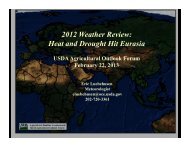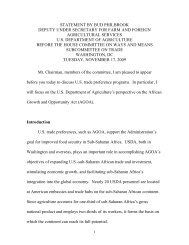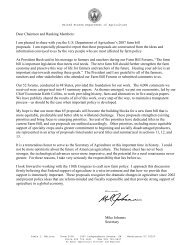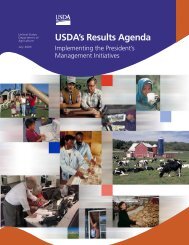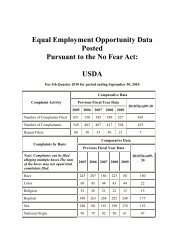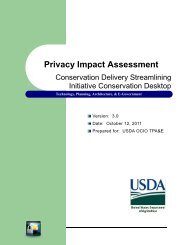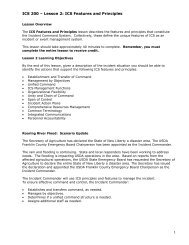Letter Report Template - US Department of Agriculture
Letter Report Template - US Department of Agriculture
Letter Report Template - US Department of Agriculture
- No tags were found...
Create successful ePaper yourself
Turn your PDF publications into a flip-book with our unique Google optimized e-Paper software.
United States <strong>Department</strong> <strong>of</strong> <strong>Agriculture</strong>Office <strong>of</strong> Inspector General
UNITED STATES DEPARTMENT OF AGRICULTUREOFFICE OF INSPECTOR GENERALWashington, D.C. 20250INFORMATIONAL MEMORANDUM FOR THE SECRETARYFROM: Phyllis K. Fong August 10, 2012Inspector GeneralSUBJECT:Management ChallengesThe <strong>Report</strong>s Consolidation Act <strong>of</strong> 2000 requires the U.S. <strong>Department</strong> <strong>of</strong> <strong>Agriculture</strong> (<strong>US</strong>DA),Office <strong>of</strong> Inspector General (OIG), to report annually on the most serious managementchallenges <strong>US</strong>DA and its agencies face. 1 To identify these departmental challenges, we examineissued audit reports where corrective actions have yet to be taken, assess ongoing investigativeand audit work to ascertain significant vulnerabilities, and analyze new programs and activitiesthat could pose significant challenges due to their range and complexity. We discussed ourcurrent challenges with <strong>US</strong>DA <strong>of</strong>ficials and considered all comments received.This year, we have removed one challenge from those included in last year’s report—Challenge 8, which highlighted the need to carefully oversee the $28 billion in AmericanRecovery and Reinvestment Act (Recovery Act) funds provided to <strong>US</strong>DA agencies andprograms. With spending from the Recovery Act winding down, OIG is concluding its workrelating to these funds and how they were spent and expects to issue its last reports on this topicin the coming months.We have also added a new challenge for <strong>US</strong>DA concerning the need to plan for succession andreduced staffing in many <strong>US</strong>DA agencies. For some time, the Federal Government has beenanticipating the retirement <strong>of</strong> a significant portion <strong>of</strong> its experienced work force as employees <strong>of</strong>the Baby Boomer generation reach retirement age. Given the constrained budget situation,<strong>US</strong>DA must ensure that it has adequate staff in place to accomplish critical missions such asinspecting meat processing plants and overseeing billions <strong>of</strong> dollars in loans. We have thereforeelevated this issue to Challenge 9.Finally, we discuss several emerging issues that may develop into significant concerns: animalwelfare, the reporting <strong>of</strong> performance measures, and duplication in <strong>US</strong>DA programs andoperations.1 Public Law 106-531.
INFORMATIONAL MEMORANDUM FOR THE SECRETARY 2We would like to close by expressing our appreciation to <strong>US</strong>DA Secretary Thomas J. Vilsackand Deputy Secretary Kathleen Merrigan for their ongoing support <strong>of</strong> our work and theircommitment to excellence at <strong>US</strong>DA. We look forward to working with the <strong>Department</strong> toaddress the management challenges we describe and mitigate any emerging issues.If you have any questions or would like to discuss these issues, please contact me (202-720-8001) or Deputy Inspector General David Gray (202-720-7431). You or your staff may alsocontact Audit’s Assistant Inspector General, Gil H. Harden (202-720-6945), or Investigations’Assistant Inspector General, Karen Ellis (202-720-3306).Attachment:Major <strong>US</strong>DA Management Challengescc:Subcabinet OfficialsAgency Administrators
Interagency Communication, Coordination, andProgram Integration Need Improvement(Challenge 1)Like many departments within the Federal Government, <strong>US</strong>DA faces a challenge in coordinatingthe various agencies and programs within its purview. This challenge is particularly pressing for<strong>US</strong>DA because several <strong>of</strong> its agencies provide payments to producers for programs that havecomplementary and interlocking missions. Likewise, <strong>US</strong>DA divides responsibilities for foodresearch among several agencies, which also requires a high degree <strong>of</strong> intradepartmentalcooperation. <strong>US</strong>DA agencies must understand these interrelationships and the need to worktogether to create a cohesive, integrated system <strong>of</strong> program administration. Such an approachshould increase organizational communication; streamline operations; reduce spending; andimprove program efficiency, compliance, and integrity.Farm ProgramsThe importance <strong>of</strong> coordinating the delivery <strong>of</strong> various <strong>US</strong>DA programs was illustrated by thechallenges the Animal and Plant Health Inspection Service (APHIS) and the Risk ManagementAgency (RMA) faced as they responded to the outbreak <strong>of</strong> citrus canker in Florida. In order toeradicate this disease, Florida took steps to remove infected trees and nearby trees that may havebeen exposed. These steps affected many Floridians who depend on citrus for their livelihood.In response, <strong>US</strong>DA implemented three different programs to assist affected growers.APHIS implemented the Citrus Canker Lost Production Program and the Citrus Canker TreeReplacement Program to compensate eligible Florida commercial citrus growers for lostproduction and tree losses. Meanwhile, RMA modified one <strong>of</strong> its insurance products—theFlorida Fruit Tree Pilot Crop Insurance Program—so that growers could be indemnified forcitrus canker tree losses. Together, these three programs provided Florida citrus growers withsignificant benefits: APHIS, through its two programs, made $474 million in payments togrowers, and RMA, through its approved insurance providers, paid growers $100.8 million fortree losses due to citrus canker.Unfortunately, these three programs encountered coordination problems. First, APHIS did notcoordinate with RMA to determine the amount <strong>of</strong> indemnity payments growers already receivedbefore APHIS calculated its payments, even though Federal regulations required APHIS toreduce its citrus canker lost production payments by the amount <strong>of</strong> any tree payments thatgrowers received from RMA. 1 Due to these two agencies’ failure to coordinate more closely,APHIS issued erroneous payments <strong>of</strong> $1.1 million.Similarly, APHIS did not report $290.9 million in Citrus Canker Tree Replacement Programpayments to the Internal Revenue Service (IRS) from fiscal year (FY) 2001 through FY 2007,even though these payments were for fruit-bearing trees, which are capital assets. This failure to1 Title 7 Code <strong>of</strong> Federal Regulations 301.75-16(b)(2)(i), January 1, 2004.MANAGEMENT CHALLENGES 2012 1
coordinate with the IRS means that the Government has no assurance that growers properlyreported tree replacement payments that may be subject to taxes. 2<strong>Agriculture</strong>-Related ResearchIn response to Colony Collapse Disorder (CCD)—a disorder that interferes with honey beepollination and endangers $15 billion annually in added crop value—<strong>US</strong>DA led a Federal/non-Federal collaboration that took action to better understand the disorder and mitigate the damageto bee colonies. Four <strong>US</strong>DA agencies—the Agricultural Research Service, the National Institute<strong>of</strong> Food and <strong>Agriculture</strong>, APHIS, and the Natural Resources Conservation Service (NRCS)—collaborated to develop an action plan to address the CCD crisis through surveying andcollecting data, analyzing samples, researching the causes <strong>of</strong> the disorder, and mitigating thedisorder’s effects.The CCD Action Plan and the Food, Conservation, and Energy Act <strong>of</strong> 2008 (2008 Farm Bill)prescribed CCD-related actions by the National Agricultural Statistics Service (NASS), RMA,and the Farm Service Agency (FSA). OIG audited these efforts and found that <strong>US</strong>DA’simplementation <strong>of</strong> the CCD Action Plan and CCD-related actions under the 2008 Farm Bill wasadequate, except that <strong>US</strong>DA had not completed a comprehensive survey <strong>of</strong> bee colony losses andthe resulting agricultural damage. This occurred because <strong>of</strong> insufficient funds and because theCCD Steering Committee did not adequately communicate the need for performing such acomprehensive survey. No one on the Steering Committee was specifically authorized ordesignated to ensure that all parts <strong>of</strong> the CCD Action Plan were completed and that fundingproblems were resolved.We recommended that the Under Secretary for Research, Education, and Economics seekadequate funding and facilitate communications to conduct a comprehensive survey <strong>of</strong> honey beecolony production and health. <strong>Department</strong>al <strong>of</strong>ficials agreed with the need to complete thissurvey but expressed concerns about their ability to fund it.Examples <strong>of</strong> Work We Anticipate Completing in the Future• Recovery Act Broadband Initiatives Program—Pre-approval Controls. This audit isassessing the Rural Utilities Service’s (R<strong>US</strong>) internal controls over the approval <strong>of</strong>broadband loan and grant applications and whether R<strong>US</strong> effectively coordinated with theNational Telecommunications and Information Administration <strong>of</strong> the <strong>Department</strong> <strong>of</strong>Commerce and the Federal Communications Commission.• <strong>US</strong>DA Controls over Shell Egg Inspections. This audit is assessing <strong>US</strong>DA’s efforts tocontrol contaminants such as Salmonella in shell eggs, an endeavor requiring extensivecoordination both between <strong>US</strong>DA agencies and with the Food and Drug Administration(FDA), part <strong>of</strong> the <strong>Department</strong> <strong>of</strong> Health and Human Services.2 <strong>US</strong>DA Payments for 2005 Citrus Canker Tree Losses (50099-0046-At, March 2011).2 MANAGEMENT CHALLENGES 2012
Strong, Integrated Internal Control Systems Still Needed(Challenge 2)<strong>US</strong>DA managers are responsible for controlling the programs they oversee through internalsystems that bring about desired objectives, such as administering crop insurance correctly andmaking payments accurately. 3 These internal controls consist <strong>of</strong> the policies, procedures, andorganizational structures that collectively determine how a program is implemented and how itsrequirements are met. In effect, internal controls are the tools managers use to ensure thatprograms achieve intended results efficiently and effectively; they provide for program integrityand proper stewardship <strong>of</strong> resources. Since systemic control flaws can yield systemic programweaknesses—e.g., unrealized objectives and improper payments—managers must continuouslyassess and improve their internal control systems. When they identify a widespread deficiency,they must fix the problem before it undermines the program.Over the years, <strong>US</strong>DA agencies have tended to resolve individual issues instead <strong>of</strong> strengtheningsystemically weak controls. For example, our audits <strong>of</strong> RMA have revealed several weaknessesin how the agency ensures that participants comply with Federal Crop Insurance Programrequirements. Approved insurance providers (AIP) have not always carried out theirresponsibilities to comply with program requirements and protect program integrity. The mostrecent OIG audit <strong>of</strong> this weakness found that AIPs circumvented established procedures foradjusting losses. They failed to follow either RMA’s general loss procedures for adjusting citruslosses or the emergency loss procedures RMA issued to expedite Hurricane Wilma-relatedpayments. Instead, they used procedures or allowed options that were not approved by RMA,resulting in overpaid indemnities totaling more than $5.5 million. 4 AIPs stumbled at each stage,but RMA’s oversight was not adequate to detect or prevent these missteps. Although RMAagreed to our recommended corrective actions in response to these and other reports, it did notsee the problems as symptoms resulting from systemic flaws in its internal controls. Instead,RMA regarded the efforts <strong>of</strong> its individual compliance units as separate efforts rather thancoordinated activities serving a shared, strategic goal <strong>of</strong> promoting program compliance andintegrity. 5Similarly, other agencies have regarded a series <strong>of</strong> audits as isolated cases needing resolutioninstead <strong>of</strong> patterns pointing toward systemic control flaws. For NRCS, this approach is partlyattributable to its tendency to rely on participants to self-certify, as well as its decentralizedorganizational structure. NRCS delegates broad authority to its field units—State, area, anddistrict <strong>of</strong>fices—without having an adequate system <strong>of</strong> oversight, monitoring, and review toensure compliance with national policies. We have identified significant control deficiencies inour most recent audits <strong>of</strong> four NRCS programs: the Wetlands Reserve Program, the ConservationSecurity Program, the program to rehabilitate flood control dams, and the Farm and Ranch3 Here and below, we have drawn from the Office <strong>of</strong> Management and Budget’s (OMB) description <strong>of</strong> Federalmanagers’ obligations in Management’s Responsibility for Internal Control (Circular A-123, 2006 revision).4 Citrus Crop Indemnity Payments from Hurricane Wilma in Florida (05099-0029-At, September 2011).5 Risk Management Agency Compliance Activities (05601-0011-At, September 2009).MANAGEMENT CHALLENGES 2012 3
Lands Protection Program in Michigan. 6 In each, we found a significant number <strong>of</strong> instanceswhere NRCS State and local staff either did not follow established procedures or relied on otherparties—including producers and landowners—to ensure compliance. This resulted in improperpayments and unrealized program objectives. In our audit <strong>of</strong> NRCS’ program to rehabilitatedams, for example, we found a significant risk to public safety when the agency relied on ownersto volunteer their flood control dams for rehabilitation. Many owners did not come forward,leaving 80 percent <strong>of</strong> the Nation’s highly hazardous dams unexamined.Our review <strong>of</strong> the Collection, Harvest, Storage, and Transportation Matching Payments portion<strong>of</strong> FSA’s Biomass Crop Assistance Program (BCAP) demonstrates why integrating a stronginternal control system into programs is a critical challenge for the <strong>Department</strong> and its agencies.The 2008 Farm Bill created BCAP to support producing crops for renewable energy, includingproviding matching payments for those involved in collecting, harvesting, storing, andtransporting biomass. However, in an effort to quickly implement the program to comply with adeadline established in a Presidential memorandum, FSA implemented BCAP without creatingan effective system <strong>of</strong> program-specific internal controls. 7 Instead, the agency used control toolsfrom other programs (contracts, information technology (IT) support, etc.) and did not provide itsstaff with adequate guidance or oversight. This led to inequitable treatment <strong>of</strong> programparticipants and improper payments, among other problems. 8 The resources involved weresignificant—FSA spent over $243 million on this portion <strong>of</strong> BCAP in 2009 and 2010.Our review <strong>of</strong> the establishment <strong>of</strong> soil rental rates for FSA’s Conservation Reserve Program(CRP) found that FSA lacks effective controls to ensure the reasonableness <strong>of</strong> the soil rentalrates used for payments on CRP contracts. In 2010, FSA signed about 46,000 contractsinvolving about 4.3 million acres and annual payments totaling about $200 million. Over the10-year life <strong>of</strong> the contracts, FSA will pay producers about $2 billion. In order to determine theCRP payment producers will receive for enrolling their land in the program, FSA calculates asoil rental rate, which is determined by multiplying the county average rental rate by the groupedsoil productivity factor. We found that the agency did not adhere to policies and regulations itestablished to ensure the reasonableness <strong>of</strong> county average rental rates, and did not use the mostrecent NRCS soil productivity factors in calculating most <strong>of</strong> the approved soil rental rates.OIG calculated that the potentially unsupported rental payments could total as much as$127 million over the 10-year life <strong>of</strong> the contracts. Further, we calculated that FSA’s failure touse NRCS productivity data resulted in the questionable accuracy <strong>of</strong> $1.4 billion in rentalpayments over the same timeframe. 9Such control issues can also have an effect on public safety and security. For example, weevaluated whether current laws and <strong>US</strong>DA regulations provide sufficient authority to control6 Natural Resources Conservation Service Wetlands Reserve Program Wetlands Restoration and Compliance(10099-0004-SF, August 2008); Natural Resources Conservation Service Conservation Security Program (10601-0004-KC, June 2009); Rehabilitation <strong>of</strong> Flood Control Dams (10601-0001-At, July 2009); and Controls Over theFarm and Ranch Lands Protection Program in Michigan (10099-0003-Ch, September 2011).7 "Memorandum on Bi<strong>of</strong>uels and Rural Economic Development," Daily Compilation <strong>of</strong> Presidential Documents(May 5, 2009).8 Biomass Crop Assistance Program: Collection, Harvest, Storage, and Transportation Matching Payments Program(03601-0028-KC, May 2012).9 Conservation Reserve Program: Soil Rental Rates (03601-0051-Te, July 2012).4 MANAGEMENT CHALLENGES 2012
genetically engineered (GE) animal and insect research. 10 In addition, we assessed whether<strong>US</strong>DA agencies involved in this research have sufficient controls in place to ensure thatGE animals and insects will not be accidentally released, which could harm commerce, theenvironment, and public health. We found that the <strong>Department</strong> has not issued regulations thatpertain specifically to introducing GE animals or insects (through import, interstate movement,or field release). <strong>US</strong>DA also needs to be more transparent and accountable with respect toGE animals and insects by developing a regulatory framework with a clearly defined scope andrequirements.In recent years, <strong>US</strong>DA agencies have continued to make steady progress in closing late auditsand have generally been more timely in implementing corrective action plans in response to auditrecommendations. We continue to maintain that implementing effective corrective actions inresponse to audit recommendations is key for program integrity and effectiveness. However,agencies must also consider the relation between these individual issues and their overall system<strong>of</strong> internal controls. As stewards <strong>of</strong> Federal resources, "[a]gencies should carefully considerwhether systemic weaknesses exist that adversely affect internal control across organizational orprogram lines," and senior <strong>US</strong>DA managers "should be involved in identifying and ensuringcorrection <strong>of</strong> systemic weaknesses." 11 When <strong>US</strong>DA and its agencies strengthen their overallinternal controls, they also strengthen their programs.Examples <strong>of</strong> Work We Anticipate Completing in the Future• RMA: Validity <strong>of</strong> New Producers. Our review is assessing how RMA has administeredthe new producer program procedures for the crop insurance program to preventimproper increases to yield guarantees.• NRCS Emergency Watershed Protection Program Floodplain Easements—FieldConfirmations. We are assessing whether: (1) program participants and land accepted foreasements are eligible; (2) NRCS’ methodology to select and acquire easementsfunctions adequately to achieve program efficiency and obtain quality easements; and(3) the determined valuation results are fair compensation for the easement.• NRCS—Review <strong>of</strong> Compliance and Monitoring Activities. This audit is determining if theagency’s compliance and monitoring activities are adequate to strengthen programintegrity and to reduce fraud, waste, and abuse.10 Controls over Genetically Engineered Animal and Insect Research (50601-0016-Te, May 2011).11 Sec. IV(B) "Identification <strong>of</strong> Deficiencies," and sec. IV(C) "Role <strong>of</strong> a Senior Management Council" in OMB’sManagement’s Responsibility for Internal Control (Circular A-123, 2006 revision).MANAGEMENT CHALLENGES 2012 5
Information Technology Security Needs Continuing Improvement(Challenge 3)Typically, <strong>US</strong>DA’s work is thought <strong>of</strong> in terms <strong>of</strong> the benefits and services the <strong>Department</strong>provides, which touch almost every aspect <strong>of</strong> American life. To accomplish these missions,<strong>US</strong>DA must manage vast amounts <strong>of</strong> data associated with its many programs and operations.This critical information ranges from agricultural statistics that drive domestic and globalmarkets to data-driven inspection systems that help ensure our food is safe. <strong>Department</strong>employees must be able to access, manipulate, and communicate this information to deliverprograms effectively. Additionally, the general public can apply for many program benefits andother services via the internet. It is therefore critical that the <strong>Department</strong> protect the security,confidentiality, and integrity <strong>of</strong> its IT infrastructure.Over the last several years, however, we have found that <strong>US</strong>DA’s IT systems remain vulnerablein many critical areas. The Federal Information Security Management Act <strong>of</strong> 2002 (FISMA)requires OIG to annually review the <strong>Department</strong>’s cybersecurity initiatives, including those thatshield IT equipment and systems from theft, attack, and intrusion. Since 2001, our audits havereported serious weaknesses in the design <strong>of</strong> <strong>US</strong>DA’s overall IT security program and itseffectiveness. 12 Most significantly, the current security program does not have a solidfoundation because the <strong>Department</strong> has not fully deployed basic analytic tools that determineaccurate system inventories, or performed appropriate risk assessments and timely vulnerabilityscans. <strong>US</strong>DA is also not well prepared to prevent or respond to emergencies because it lacksadequate mechanisms to continuously monitor systems, respond adequately to incidents, andrecover from disasters.With new modes <strong>of</strong> delivering information and using computer programs—i.e., cloudcomputing—come new risks. Cloud computing essentially centralizes applications and data<strong>of</strong>fsite in a system hosted by a third party, outside <strong>of</strong> <strong>US</strong>DA’s internal security walls. Alongwith the risk inherent in no longer having direct control over data, each time an employeereaches out from a smartphone, laptop, or desktop computer to use these cloud services, the<strong>Department</strong>’s sensitive information is susceptible to prying and hacking. As the <strong>Department</strong>moves to integrate more cloud services into its operations, it needs to prepare for the associatedrisks. In particular, <strong>US</strong>DA must ensure that third-party service providers meet required accessand security requirements. Further, the Office <strong>of</strong> the Chief Information Officer (OCIO) shouldprovide <strong>of</strong>ficial guidance about using and acquiring data through cloud services.In addition, like other Federal departments, <strong>US</strong>DA increasingly relies on smartphones and otherhandheld wireless devices to conduct its day-to-day business. These devices are small,inexpensive, and powerful, but their portability poses new security risks for Federal agencies.12 For example, see the last 4 years <strong>of</strong> our FISMA audits: U.S. <strong>Department</strong> <strong>of</strong> <strong>Agriculture</strong>, Office <strong>of</strong> the ChiefInformation Officer, Fiscal Year 2011 Federal Information Security Management Act (50501-0002-12, November2011); U.S. <strong>Department</strong> <strong>of</strong> <strong>Agriculture</strong>, Office <strong>of</strong> the Chief Information Officer, Fiscal Year 2010 FederalInformation Security Management Act (50501-0002-IT, November 2010); U.S. <strong>Department</strong> <strong>of</strong> <strong>Agriculture</strong>, Office<strong>of</strong> the Chief Information Officer, Fiscal Year 2009 Federal Information Security Management Act (50501-0015-FM,November 2009); and U.S. <strong>Department</strong> <strong>of</strong> <strong>Agriculture</strong>, Office <strong>of</strong> the Chief Information Officer, Fiscal Year 2008Federal Information Security Management Act <strong>Report</strong> (50501-0013-FM, September 2008).6 MANAGEMENT CHALLENGES 2012
Since smartphones can be easily lost or stolen, misplaced devices could be used to access, andpotentially abuse, private or classified information. Given concerns about the security <strong>of</strong> the10,000 wireless handheld devices deployed at <strong>US</strong>DA, we performed an audit to evaluate the<strong>Department</strong>’s management and implementation <strong>of</strong> security measures over the use <strong>of</strong> mobilehandheld device technology. During our audit we found that devices were not adequatelysecured, as defined by guidance issued by the National Institute <strong>of</strong> Standards and Technology.For example, we found wireless handheld devices that were not password protected, that had noanti-virus s<strong>of</strong>tware installed, and that were not configured to encrypt removable media, amongother deficiencies. We also found that not all <strong>of</strong> the <strong>Department</strong>’s Blackberry servers weresecured in accordance with <strong>Department</strong>al guidance; users were able to disable their passwords orbypass the <strong>Department</strong>’s internet content filters. Ultimately, these problems occurred because<strong>US</strong>DA chose to deploy wireless handheld devices using a decentralized approach, but did notprovide its agencies with clear guidance on how they were to configure their devices and servers.OCIO has begun to implement the corrective actions proposed. 13Going forward, we believe <strong>US</strong>DA needs to lay the foundation for an effective, comprehensiveIT security plan. We continue to note that the <strong>Department</strong> needs to work with all <strong>of</strong> its agenciesto identify overall risks, and then prioritize the risks so that it will have a solid basis for a timephasedplan to systematically mitigate them. Based on audit work conducted in FYs 2011 and2012, we noted that OCIO did not strategically plan, prioritize, and manage its efforts to be moreeffective. For instance, we found that several <strong>of</strong> OCIO’s projects did not meet the purposesoutlined in its request to Congress for additional funding or address the <strong>Department</strong>’s mostcritical IT security concerns. In addition, we noted that OCIO needs to adequately developoversight mechanisms, communicate and coordinate within OCIO, plan projects, and determinehow to effectively utilize its resources. 14Agency managers should also make IT security an ongoing top priority and commit tocomplying with Federal security requirements. However, our audit work found that in FYs 2011and 2012, <strong>US</strong>DA management did not ensure that all requirements for domain name systemswere met and that National Institute <strong>of</strong> Standards and Technology guidance was completelyimplemented and adhered to. 15 These requirements are essential for ensuring the security <strong>of</strong> datamoved across <strong>US</strong>DA’s networks.With 33 agencies and <strong>of</strong>fices to protect, each usually with its own IT infrastructure, managing ITsecurity will remain a formidable responsibility for <strong>US</strong>DA.Examples <strong>of</strong> Work We Anticipate Completing in the Future• FY 2012 FISMA <strong>Report</strong>. This audit is assessing <strong>US</strong>DA’s IT security posture based onquestions prepared by the U.S. <strong>Department</strong> <strong>of</strong> Homeland Security’s National CyberSecurity Division and OMB.13 <strong>US</strong>DA’s Management and Security Over Wireless Handheld Devices (50501-0001-IT, August 15, 2011).14 Audit <strong>of</strong> the Office <strong>of</strong> the Chief Information Officer’s FYs 2010 and 2011 Funding Received for SecurityEnhancements (88401-0001-12, August 2012).15 <strong>US</strong>DA’s Configuration, Management, and Security over Domain Name System Servers (50501-0001-12, April2012).MANAGEMENT CHALLENGES 2012 7
• Review <strong>of</strong> Selected Controls <strong>of</strong> the eAuthentication System. Our objective is to obtainreasonable assurance concerning whether the application controls for eAuthenticationoperate effectively.• Review <strong>of</strong> the Procurement Operations Division. This audit is evaluating theeffectiveness <strong>of</strong> the controls <strong>US</strong>DA has in place to ensure the integrity <strong>of</strong> the requisition,solicitation, and procurement processes for IT contracts.8 MANAGEMENT CHALLENGES 2012
Material Control Weaknesses in Civil Rights Should Be Mitigated(Challenge 4)In an April 2009 memorandum to all <strong>US</strong>DA employees, the Secretary <strong>of</strong> <strong>Agriculture</strong> stated thatcivil rights was one <strong>of</strong> the <strong>Department</strong>’s top priorities, emphasizing that there was significantprogress to be made. <strong>US</strong>DA has received public attention with the Pigford I and Pigford IIsettlements, which stem from a series <strong>of</strong> discrimination complaints made against <strong>US</strong>DA byAfrican American farmers. Similar lawsuits, known as Keepseagle, Garcia, and Love, have beenfiled by Native American, Hispanic, and female farmers. Such civil rights complaints are notjust costly for <strong>US</strong>DA; they also affect public confidence in <strong>US</strong>DA’s administration <strong>of</strong> itsprograms. Because <strong>US</strong>DA is committed to ensuring that its conduct is just and equitable, the<strong>Department</strong> needs to timely and efficiently address civil rights complaints.Processing such complaints involves multiple levels and agencies within <strong>US</strong>DA. For this reason,complaint resolution requires continual coordination to ensure that the process runs smoothly.With over 300 programs to manage and a backlog <strong>of</strong> civil rights complaints, timely resolution isdifficult. <strong>US</strong>DA has implemented various initiatives and devoted valuable resources towardsresolving them. For example, in 2005, <strong>US</strong>DA developed 13 initiatives that addressed thebacklog <strong>of</strong> complaints and their timely handling. As a result, we removed civil rights from thelist <strong>of</strong> management challenges in 2005. However, in 2007, we found that despite theseimprovements, many <strong>of</strong> the same issues remained, and we reinstated the challenge. 16 In anApril 2009 memorandum, the Secretary <strong>of</strong> <strong>Agriculture</strong> noted that 3,000 <strong>of</strong> nearly14,000 complaints filed since the beginning <strong>of</strong> the decade had not been processed.<strong>US</strong>DA continues to make concerted efforts towards decreasing complaint processing time. TheApril 2009 memorandum by the Secretary and testimony by the Assistant Secretary for CivilRights outlined steps to improve issues related to equal employment opportunity (EEO), civilrights, and program delivery. Their proposed actions included obtaining an outside, independentanalysis <strong>of</strong> program delivery; creating a task force to review a sample <strong>of</strong> civil rights complaints;prioritizing complaints processing; suspending loan foreclosures temporarily to give the<strong>Department</strong> time to review those possibly involving discriminatory conduct; and requiring theOffice <strong>of</strong> the Assistant Secretary for Civil Rights (OASCR) to implement management controlsover handling complaints timely and consistently. The Secretary also announced his strategy forresolving all open EEO complaints by using alternative dispute resolution, and gave each Underand Assistant Secretary responsibility for handling all open <strong>Department</strong>al EEO complaintswithin 60 days.OIG recently completed an audit reviewing how OASCR oversees agreements reached inprogram complaints. 17 We found that OASCR has significantly improved its monitoring <strong>of</strong>settlement agreements and closure <strong>of</strong> program complaints. In addition, we determined thatOASCR improved the organization <strong>of</strong> case files in its file room and took steps to improve the16 Review <strong>of</strong> the U.S. <strong>Department</strong> <strong>of</strong> <strong>Agriculture</strong>’s Accountability for Actions Taken on Civil Rights Complaints(60601-0004-Hy, May 2007).17 Review <strong>of</strong> the Office <strong>of</strong> the Assistant Secretary for Civil Rights’ Oversight <strong>of</strong> Agreements Reached in ProgramComplaints (60601-0001-23, August 2012).MANAGEMENT CHALLENGES 2012 9
program complaints process by hiring a contractor to conduct a review <strong>of</strong> OASCR’smanagement processes. However, we determined that OASCR needs to strengthen itsprocedures for settlement agreements so that it can maintain current improvements, support itsdecisions, process cases timely, and report them accurately.While we acknowledge that recent OASCR initiatives are beginning to address this challenge,we continue to emphasize that formalized processes and controls are necessary to ensure that<strong>US</strong>DA can meet reasonable and measurable milestones. Specifically, OASCR must develop adetailed, formal plan to process employment complaints in collaboration with <strong>US</strong>DA agenciesand establish the necessary monitoring framework to intervene when complaint processingexceeds timeframes.OIG also recently issued a "fast report" to the Assistant Secretary for Administration that advised<strong>Department</strong>al Management to delay the announcement <strong>of</strong> the FY 2012 recipients for grantsfunded through the Outreach and Assistance for Socially Disadvantaged Farmers and RanchersProgram (Section 2501 Program). Our audit disclosed that the Office <strong>of</strong> Advocacy and Outreachhad not adhered to the agency’s draft policies and procedures, as well as the guidelines cited inthe Funding Opportunity Announcement issued in November 2011, when selecting theFY 2012 applicants. Thus, we concluded that the applicants selected to receive the grants maynot have been the most meritorious and deserving applicants. The selection <strong>of</strong> less meritoriousapplicants could negatively impact assistance to socially disadvantaged farmers and ranchers,and could expose the <strong>Department</strong> to unnecessary criticism and, potentially, even legal action. 18<strong>US</strong>DA agreed and took action to address these problems.Examples <strong>of</strong> Work We Anticipate Completing in the Future• Review <strong>of</strong> Pigford II Adjudicated Claims. As required by the Claims Resolution Act <strong>of</strong>2010, this audit is reviewing Pigford II claims based on a statistical sample <strong>of</strong> adjudicatedclaims.18 Controls over the Grant Management Process <strong>of</strong> the Office <strong>of</strong> Advocacy and Outreach—Section 2501 ProgramGrantee Selection for Fiscal Year 2012 (91011-0001-21, May 2012).10 MANAGEMENT CHALLENGES 2012
Proactive, Integrated Strategy Is Necessary To Increase AgriculturalCommerce and Trade(Challenge 5)Given the importance <strong>of</strong> U.S. agriculture to the economy—in 2011, the Nation’s farms andranches produced $409 billion in goods 19 —<strong>US</strong>DA has a longstanding and deeply rooted interestin promoting the export <strong>of</strong> our commodities worldwide. Over the last several years, themonetary total <strong>of</strong> U.S. agricultural exports has risen significantly because <strong>of</strong> several factors,including adverse weather conditions in major agricultural areas, the U.S. dollar’s decliningvalue, and increased demand in countries such as India and China. In FY 2011, U.S. agriculturalexports totaled $137 billion—an increase <strong>of</strong> 27 percent from the preceding fiscal year’s$109 billion.In this positive environment for U.S. agricultural goods, <strong>US</strong>DA’s challenge is to capitalize on thehistoric moment. In 2007, we reported that <strong>US</strong>DA had not integrated its current country-specificmarketing strategies into a focused, global strategy capable <strong>of</strong> responding effectively tointernational market trends. We recommended that the <strong>Department</strong> develop a global marketstrategy to increase U.S. export opportunities and competitiveness and, in 2010, the <strong>Department</strong>20, 21announced a global market strategy in answer to the President’s call for an export initiative.Developing a global market strategy for U.S. agricultural goods is especially vital because theNation’s production is increasingly devoted to GE crops. In 2011, GE corn constituted88 percent <strong>of</strong> all corn planted in the United States; GE cotton constituted 90 percent <strong>of</strong> plantedcotton; and GE soybeans constituted 94 percent <strong>of</strong> soybeans planted.While these products are, in many ways, beneficial for agriculture, <strong>US</strong>DA faces significantchallenges related to exporting them. As part <strong>of</strong> its global market strategy, <strong>US</strong>DA needs acoordinated, comprehensive strategy to address the challenges that U.S. producers face whenexporting GE commodities. We concluded that an effective export strategy for GE commoditiesshould include elements such as: (1) a clear purpose, scope, and methodology; (2) a statement <strong>of</strong>problems to be overcome; (3) goals and outcome-related performance measures; and (4) wellintegratedinternal and external partner accomplishments. 22In order to remain competitive in global agricultural exports, <strong>US</strong>DA should finalize acoordinated and consolidated global market strategy, which includes guidelines and strategies forworking with countries reluctant to import GE crops. The strategy should also address openingnew markets for U.S. agricultural products, particularly high-value or processed products.19 Value <strong>of</strong> agricultural sector production forecast for 2011, as <strong>of</strong> February 2012.20 Foreign Agricultural Service: Implementation <strong>of</strong> the Trade Title <strong>of</strong> the 2002 Farm Bill and the 2002 President’sManagement Agenda (50601-0012-At, March 2007).21 In March 2010, the President issued the National Export Initiative, an executive order to enhance and coordinateFederal efforts to facilitate the creation <strong>of</strong> jobs in the United States through the promotion <strong>of</strong> exports and to ensurethe effective use <strong>of</strong> Federal resources. This initiative supports the Administration’s goal <strong>of</strong> doubling exports withinthe next 5 years.22 <strong>US</strong>DA’s Role in the Export <strong>of</strong> Genetically Engineered Agricultural Commodities (50601-0014-Te, February2009).MANAGEMENT CHALLENGES 2012 11
<strong>US</strong>DA is in the process <strong>of</strong> developing such a strategy and should ensure that its use <strong>of</strong> resourcesaligns with the <strong>Department</strong>’s export initiatives.Examples <strong>of</strong> Work We Anticipate Completing in the Future• Effectiveness <strong>of</strong> the <strong>Department</strong>’s Recent Efforts To Enhance Agricultural Trade. Ourreview is evaluating whether the Foreign Agricultural Service has developed andimplemented measurable strategies and actions that are effectively aligned with the<strong>Department</strong>’s strategic goals related to market access and trade promotion.12 MANAGEMENT CHALLENGES 2012
Forest Service Management and Community Action Needed To ImproveForest Health and Reduce Firefighting Costs(Challenge 6)In order to care for the 193 million acres <strong>of</strong> forests and grasslands under its supervision, theForest Service (FS) needs to ensure that it approaches complex budgetary and human resourcemanagement issues with the same dedication it brings to managing the Nation’s lands. As thelogistical challenges <strong>of</strong> managing vast natural resources have become more complicated andmore expensive, the overall cost <strong>of</strong> fighting wildfires has soared to over $1 billion per year andalready commands approximately 40 percent <strong>of</strong> the agency’s budget.Improving forest health and reducing FS’ costs are challenging goals to balance. FS’ budget isbeing stretched in many directions by competing factors, one <strong>of</strong> which is unregulated populationgrowth in residential developments next to wildlands. Given the danger to public safety,FS must spend significant funds to protect people and property in these areas from wildfires,drawing resources away from FS’ efforts to manage the forests. In addition, althoughFS’ 2012 budget dedicates $317 million to reducing hazardous fuels in forests, these fuels arestill accumulating faster than the agency can reduce them.We found that as part <strong>of</strong> FS’ efforts to improve the efficiency with which it operates, the agencycould improve how it manages the "special use" permits it processes for a wide variety <strong>of</strong>purposes such as setting up communication relays, bottling spring water, and outfitting andguiding on Federal lands. Currently, FS processes thousands <strong>of</strong> applications and monitors morethan 74,000 authorizations for over 180 types <strong>of</strong> uses, but lacks the authority to keep the fees itcharges. In 2008, FS collected $13.4 million for land use authorizations that it had to remit tothe <strong>Department</strong> <strong>of</strong> the Treasury, but the Special Use Program had to turn away applicants due toa lack <strong>of</strong> resources for processing applications. Finally, we found that six out <strong>of</strong> nine FS regionshad not periodically updated their fees based on the fair market value <strong>of</strong> the use <strong>of</strong> the land, norwere they adjusting the fees for inflation. As a result, authorization holders were paying muchless in fees than the fair market value would indicate. Had the regions updated their minimumland use fees as required, we determined that FS could have collected nearly $5.4 million inadditional fees over the past 7 years. 23FS can also improve how it addresses issues resulting from the sale <strong>of</strong> private forest land witheasements for residential development and commercial use—the mingling <strong>of</strong> residentialdevelopments and forestlands is a contributing factor to the high costs <strong>of</strong> fighting fires. Thisproblem arises from the fact that FS and timber companies <strong>of</strong>ten share roads on national forestland. The Forest Roads and Trails Act (FRTA) authorizes FS to formalize agreements withtimber companies on the maintenance and use <strong>of</strong> these shared roads.While FS personnel are properly granting and acquiring easements, they are not prepared toeffectively address the issues arising from the sale <strong>of</strong> private forest land with FRTA easementsfor residential development and commercial use. FS cannot stop development on private land orrestrict access to FRTA roads, but it should assess risks, develop strategies to lessen the impacts23 Forest Service Administration <strong>of</strong> Special Use Program (08601-0055-SF, June 2011).MANAGEMENT CHALLENGES 2012 13
<strong>of</strong> changing land use, and incorporate appropriate changes into the agency’s planning rule andstrategic plan. Further, to avoid confusion and dispute, FS should make further efforts toimplement a FRTA easement amendment, which would clarify rights and responsibilities beforesuccessor landowners come into possession <strong>of</strong> the land, and provide sufficient guidance to localfield staff on how to address landowner disputes once the land has already been sold. 24FS’ mission <strong>of</strong> managing the forests is a complex undertaking. Fortunately, public awarenessabout the impact <strong>of</strong> activities on forests and grasslands—intended and unintended—is growing.FS <strong>of</strong>ficials should work with other land management organizations and Congress to convinceState and local governments to enact appropriate building and zoning codes to better regulatedevelopments, especially in areas that are at risk <strong>of</strong> wildfire. FS should also collaborate withother land management organizations and State and local governments to reduce wildfire risk.By continuing to improve its internal controls and coordination, FS will be able to better fulfillits mission <strong>of</strong> caring for the Nation’s forests and grasslands.Examples <strong>of</strong> Work We Anticipate Completing in the Future• Forest Service’s Use <strong>of</strong> Recovery Act Funds to Reduce Hazardous Fuels and RestoreEcosystem on Non-Federal Lands. Our review is determining whether FS and recipients<strong>of</strong> Recovery Act funds for hazardous fuels reduction and ecosystem restoration projectson non-Federal lands (1) complied with laws and regulations pertaining to Recovery Actfunding; (2) selected projects that met eligibility and program requirements; (3)accurately accounted for and timely completed projects in accordance with awardexpectations; and (4) accurately and timely reported their accomplishments.• Forest Service’s Use <strong>of</strong> Recovery Act Funds for Wildland Fire Management on FederalLands. Our review is evaluating the control systems <strong>of</strong> Recovery Act projects at field<strong>of</strong>fices to ensure projects on Federal lands met the goals and requirements <strong>of</strong> theRecovery Act, and determining whether FS timely obligated and effectively spentRecovery Act funds.• Management <strong>of</strong> Oil and Gas Resources on National Forest System Land. This audit isevaluating how FS approves oil and gas lease permit applications, monitors theoperations it approves, and reclaims FS land.24 Evaluation <strong>of</strong> Forest Service’s Processes to Obtain and Grant Rights-<strong>of</strong>-Way and Easements (08601-0001-Ch,March 2012).14 MANAGEMENT CHALLENGES 2012
Food Safety Inspection Systems Need Improved Controls(Challenge 7)Because food-borne pathogens and food contamination can put consumer health in jeopardy,<strong>US</strong>DA inspection systems work to protect the safety <strong>of</strong> the U.S. food supply. The <strong>Department</strong>provides a range <strong>of</strong> safety measures, from placing qualified inspectors in livestock and poultryslaughtering facilities to creating comprehensive data mining systems that pinpoint likely risks infood processing procedures. To maintain the confidence <strong>of</strong> consumers, Congress, and otherstakeholders, the Food Safety and Inspection Service (FSIS) should continue to improve itstechnology systems, inspection processes, and management controls to accurately assess risk andeffectively prevent contamination.Over the last several years, OIG’s work has identified areas where <strong>US</strong>DA could strengthen itsrisk assessment and management processes. Since 2000, we have reviewed <strong>US</strong>DA’s efforts toimplement the Hazard Analysis and Critical Control Point regulations. Under this system,establishments design their own food safety systems for sanitation and pathogen reduction.FSIS verifies the implementation <strong>of</strong> these plans through inspections and other activities, such asfood safety assessments. Because targeted selection is necessary for the success <strong>of</strong> FSIS’inspections and assessments, the agency needs reliable, comprehensive data to draw from. Inseveral audits, we found that then current processes did not ensure that FSIS had the volume andquality <strong>of</strong> data necessary to select establishments posing the highest public health risk. 25As part <strong>of</strong> the effort to improve the data it gathers, FSIS is in the process <strong>of</strong> implementing itsnew Public Health Information System (PHIS) that will replace many <strong>of</strong> the agency’s existingdata systems. PHIS is expected to improve the way FSIS detects and responds to food-bornehazards. 26 Many <strong>of</strong> the new system’s features were designed to address previous OIG findingsand recommendations, such as capturing food safety assessment data for risk analysis. OIG is inthe process <strong>of</strong> evaluating how FSIS has implemented PHIS.A series <strong>of</strong> major meat recalls in recent years has drawn attention to key vulnerabilities in<strong>US</strong>DA’s food safety measures. For example, a 2008 undercover video from the Humane Societyshowed egregious abuse <strong>of</strong> cattle awaiting slaughter at a California establishment. Becausemany <strong>of</strong> the cattle shown had not been presented for required inspections, this video spurred avoluntary recall <strong>of</strong> nearly 143 million pounds <strong>of</strong> raw and frozen beef—the largest such recall todate. Our audit found that slaughterhouse personnel took deliberate actions to bypass theinspections, and FSIS staff did not always comply with inspection procedures. 27 Though wefound that this incident was not a result <strong>of</strong> systemic failure, we believe FSIS must develop25 Implementation <strong>of</strong> Hazard Analysis and Critical Control Point Regulations (24001-0003-At, June 2000);Oversight <strong>of</strong> Production Process and Recall at ConAgra Plant (24601-0002-KC, September 2003); Advance MeatRecovery Products, Phase 3 (50601-0010-KC, January 2006); Issues Impacting the Development <strong>of</strong> Risk-BasedInspection at Meat and Poultry Processing Establishments (24601-0001-Hy, December 2007).26 PHIS has four components—domestic, import, export, and predictive analytics, which is a function <strong>of</strong> eachcomponent. As <strong>of</strong> January 2012, the domestic module, along with its predictive analytic function, becameoperational. The import module became operational in May 2012, and the export module is scheduled forimplementation in 2013.27 Evaluation <strong>of</strong> FSIS Management Controls over Pre-Slaughter Activities (24601-0007-KC, November 2008).MANAGEMENT CHALLENGES 2012 15
methods to quickly detect such improprieties before they significantly endanger consumer healthand animal welfare. FSIS has taken action in response to these events, such as issuing a policythat requires all non-ambulatory disabled cattle to be condemned and appointing an ombudsmanwho is responsible for humane handling issues.According to the Humane Methods <strong>of</strong> Slaughter Act, livestock may only be slaughtered byhumane methods—FSIS is responsible for enforcing the Act’s provisions in <strong>US</strong>DA-inspectedplants. When inspectors observe a humane handling violation, they issue a noncompliancerecord or take other enforcement actions to suspend plant operations, and establishments canappeal any inspection decision. At the request <strong>of</strong> the Under Secretary for Food Safety,OIG reviewed humane handling noncompliance records and other enforcement actions that weresubsequently appealed by plant management to higher FSIS management levels. We determinedthat FSIS procedures were adequate and FSIS followed its established procedures toappropriately address the appeals we reviewed. Our analysis <strong>of</strong> the data did not reveal anynegative trends or systemic problems related to inconsistent treatment or unfounded actions togrant or deny appeals in particular establishments across the country. We acknowledge thatFSIS has taken recent steps to improve inspectors’ understanding <strong>of</strong> humane handlingrequirements and educate them on the procedures to follow when a noncompliance is observed.We made no specific recommendations in this report, but we did suggest that FSIS consider howPHIS could be better utilized to track and monitor appeals <strong>of</strong> humane handling noncompliancerecords. 28At the request <strong>of</strong> Congress, OIG has also reviewed the testing FSIS performs to detectEscherichia coli O157:H7 in U.S. beef "trim." In the first phase <strong>of</strong> this work, we examined thestatistical validity <strong>of</strong> how FSIS tests for E. coli O157:H7 and found that FSIS’ trim samplingprogram does not have a sufficient statistical basis to detect contaminated product with highconfidence from a food safety standpoint. The agency did not evaluate or justify thecontamination level for E. coli O157:H7 that is associated with its N-60 sample size andconfidence level—essentially, the amount <strong>of</strong> contaminated trim that might slip through its testingsystem without being detected. For example, we found that, if E. coli O157:H7 contaminationlevel is very low, FSIS is more likely to miss contamination than to detect it. We recommendedthat FSIS reevaluate its sample parameters (size and confidence level) and redesign the samplingprogram, which FSIS has agreed to do. 29In the second phase <strong>of</strong> our E. coli O157:H7 audit, we found that, since consumers ultimately relyon industry’s testing and interventions to keep our beef E. coli O157:H7 free, it is criticallyimportant that, when plants receive multiple positive test results (otherwise known as "highevent" periods), the plants respond appropriately to these spikes in E. coli O157:H7contamination. We found, however, that FSIS has not issued detailed and sufficient guidance fordefining industry plans for high event days and setting forth the agency’s expectations for howindustry should react. Also, we found that FSIS needs to consider shifting more <strong>of</strong> its testingresources to sampling trim, instead <strong>of</strong> ground beef, for E. coli O157:H7. At present, each yearFSIS collects and tests many more samples <strong>of</strong> raw ground beef than trim (about 12,30028 Review <strong>of</strong> Appeals <strong>of</strong> Humane Handling Noncompliance Records (24601-0002-31, April 2012).29 FSIS Sampling Protocol for Testing Beef Trim for E. coli O157:H7 (24601-0009-KC, February 2011).16 MANAGEMENT CHALLENGES 2012
Efforts To Identify, <strong>Report</strong>, and Reduce Improper Payments Need To BeStrengthened(Challenge 8)<strong>US</strong>DA delivers approximately $189 billion in public services annually through more than300 programs. In FY 2011, <strong>US</strong>DA reported that 16 <strong>of</strong> its programs were vulnerable tosignificant improper payments ("high risk" programs) and estimated $5.4 billion in improperpayments for that year—a 5.36 percent error rate. This rate remained the same from FY 2010,and leaves the <strong>Department</strong> with an opportunity to realize considerable cost savings by continuingto reduce its improper payments.Improper payments occur when funds go to the wrong recipient, an ineligible recipient receives apayment, the proper recipient receives an incorrect amount <strong>of</strong> funds, documentation is notavailable to support a payment, or the recipient uses funds in an improper manner. According toOMB’s Controller, not all improper payments are fraud (i.e., most payment errors areinadvertent) or waste (i.e., a significant amount <strong>of</strong> error is based on missing documentation thatlater proves to be correct), but all improper payments affect the integrity <strong>of</strong> Governmentprograms and compromise citizens’ trust in government.The President’s 2009 Executive Order, Reducing Improper Payments and Eliminating Waste inFederal Programs (EO 13520), and the Improper Payments Elimination and Recovery Act <strong>of</strong>2010 (IPERA) strengthened Federal improper payment reduction efforts through rigorousreporting and preventative measures. 31 These measures do not simply require more stringentreporting, but also help agencies reduce improper payments by identifying underlying problems.They also require OIGs to evaluate agencies’ progress in implementing these requirements. Onthe whole, OIG noted that as <strong>US</strong>DA agencies become increasingly familiar with the newrequirements, their reports are more compliant. However, over the past 4 years, we have foundthat <strong>US</strong>DA continues to struggle to fully comply with some requirements, particularly thoseinvolving <strong>US</strong>DA’s reporting practices and preventative measures.In FY 2011, <strong>US</strong>DA and its agencies submitted the required reports, but in some instances left outcritical information or provided information that was inaccurate. The problems we observedvaried from agency to agency. For example, the Food and Nutrition Service (FNS) did not reportestimates for improper payments in one <strong>of</strong> its high risk programs because it is pursuing multipleprojects to develop an estimate <strong>of</strong> improper payments for the Family Day Care Homes MealClaims component <strong>of</strong> the Child and Adult Care Food Program. As a <strong>Department</strong>, <strong>US</strong>DA did notfully comply with four <strong>of</strong> seven reporting requirements. 32 <strong>US</strong>DA’s overall noncomplianceoccurred because the Office <strong>of</strong> the Chief Financial Officer (OCFO) has not fully developed itsreporting process to ensure that it reports all required information and that <strong>US</strong>DA agencies meet31 IPERA supplements the Improper Payments Information Act <strong>of</strong> 2002. The President also issued two Presidentialmemoranda expanding payment recovery audits and enhancing payment accuracy through a "Do Not Pay List"(Finding and Recapturing Improper Payments (Federal Register Vol. 75, No. 49) and Enhancing Payment AccuracyThrough a "Do Not Pay List" (Federal Register /Vol. 75, No. 120)).32 Fiscal Year 2011 Improper Payment Elimination and Recovery Act <strong>of</strong> 2010 Compliance Review (50024-0001-11,March 2012).18 MANAGEMENT CHALLENGES 2012
their reduction targets. OCFO continues to work on enhancing internal controls—includingguidance, oversight, and second party reviews—over the improper payment reporting process.OIG has recently completed several projects intended to assist <strong>US</strong>DA agencies as they reducetheir rate <strong>of</strong> improper payments. For example, based on a statistical sample <strong>of</strong> 122 FSA farmassistance program payments, we identified 14 errors that resulted in improper payments totaling$54,408. By using this sample to project improper payments for the entire universe <strong>of</strong> FSA farmassistance program payments, OIG estimated the total dollars improperly paid were about$28 million. This is an improvement over the $43 million in payments identified the previousyear. FSA accepted OIG’s recommendation to implement more effective second party reviewsover the manual calculation process. 33Similarly, OIG evaluated NRCS’ national-level management controls over identifying andreporting improper payments under IPERA and an executive order concerning high-dollaroverpayments. 34 We found that NRCS must improve its IPERA reviews, particularly in the area<strong>of</strong> eligibility. We questioned the accuracy <strong>of</strong> NRCS’ FY 2011 improper payment estimate <strong>of</strong>$11 million, and believe that it is understated by at least $9 million. We also found thatNRCS did not develop a dependable and centralized method for recording, tracking, andmonitoring improper payments. NRCS’ identification <strong>of</strong> high-dollar overpayments was alsohampered by the absence <strong>of</strong> a formal process.In some cases, <strong>US</strong>DA has improved its reporting and reduced its improper payment rates. Forexample, the Supplemental Nutrition Assistance Program (SNAP) has decreased its error ratefrom 8.9 percent to 3.8 percent over the past 11 years, which represents a significantimprovement given its $71.8 billion budget for FY 2011. Yet FNS still reported that it made anestimated $2.5 billion in improper SNAP payments for FY 2010. <strong>US</strong>DA’s proposed efforts toreduce such improper payments include implementing policies, controls, and procedures, as wellas creating aggressive corrective action plans to address root causes and internal control issuesfor each <strong>US</strong>DA high risk program.As part <strong>of</strong> OIG’s ongoing efforts to help minimize fraud, waste, and abuse within SNAP, OIG iscompleting a series <strong>of</strong> audits analyzing 10 States’ participant databases. 35 State agencies arerequired to check participants’ information against Federal and State databases to ensure, forexample, that people using deceased individuals’ social security numbers do not receive benefits,or that participants’ submitted income is the same as is listed in <strong>of</strong>ficial records. We reviewed33 Fiscal Year 2011 Farm Service Agency Farm Assistance Program Payments (03401-0001-11, May 2012).34 NRCS Improper Payment Review (10024-0001-11, April 2012).35 Analysis <strong>of</strong> Kansas’ Supplemental Assistance Program Eligibility Data (27002-0001-13, November 2011);Analysis <strong>of</strong> Florida’s Supplemental Assistance Program Eligibility Data (27002-0002-13, November 2011);Analysis <strong>of</strong> Louisiana’s Supplemental Assistance Program Eligibility Data (27002-0003-13, January 2012);Analysis <strong>of</strong> Alabama’s Supplemental Assistance Program Eligibility Data (27002-0004-13, January 2012); Analysis<strong>of</strong> Mississippi’s Supplemental Assistance Program Eligibility Data (27002-0005-13, January 2012); Analysis <strong>of</strong>Texas’ Supplemental Assistance Program Eligibility Data (27002-0006-13, March 2012); Analysis <strong>of</strong> Missouri’sSupplemental Assistance Program Eligibility Data (27002-0007-13, March 2012); Analysis <strong>of</strong> Massachusetts’Supplemental Nutrition Assistance Program Eligibility Data (27002-0008-13, April 2012); Analysis <strong>of</strong> New Jersey’sSupplemental Nutrition Assistance Program Eligibility Data (27002-0009-13, April 2012); and Analysis <strong>of</strong> NewYork’s Supplemental Assistance Program Eligibility Data (27002-0010-13, June 2012).MANAGEMENT CHALLENGES 2012 19
10 States and found a total <strong>of</strong> 27,044 recipients who may have received improper paymentstotaling up to approximately $3.7 million monthly.As <strong>US</strong>DA continues to address improper payments, we emphasize the importance and utility <strong>of</strong>complying with IPERA, EO 13520, and other requirements. <strong>US</strong>DA’s agencies must not onlyrecover improper payments, but also implement adequate reporting for improper paymentestimates and error rates. Based on their reporting efforts, agencies need to identify root causes<strong>of</strong> overpayments and implement necessary internal controls to prevent future overpayments. If<strong>US</strong>DA takes these steps, the public can be more confident that <strong>US</strong>DA conscientiously andeffectively accounts for, uses, and—when necessary—recovers taxpayer dollars.Examples <strong>of</strong> Work We Anticipate Completing in the Future• FNS—Analysis <strong>of</strong> SNAP Databases. This audit is determining whether FNS and States areeffectively using available tools to monitor SNAP. It will also evaluate the integrity <strong>of</strong>amounts FNS reports for recipient and retailer fraud.• <strong>US</strong>DA—Fiscal Year 2011, Executive Order 13520, Reducing Improper Payments, High-Dollar <strong>Report</strong> Review. This audit is reviewing FY 2011 quarterly high-dollar reports andassessing the level <strong>of</strong> risk associated with the applicable programs, determining the extent <strong>of</strong>oversight warranted, and providing the agency head with recommendations, if any, formodifying the agency’s plans.20 MANAGEMENT CHALLENGES 2012
Planning Needed for Succession Planning and Reduced Staffing(Challenge 9)For some time, <strong>US</strong>DA, like most <strong>of</strong> the Federal Government, has been anticipating theretirement <strong>of</strong> a significant portion <strong>of</strong> its experienced workforce as employees <strong>of</strong> the BabyBoomer generation reach retirement age. As <strong>of</strong> April 2011, over half <strong>of</strong> <strong>US</strong>DA’s seniorexecutive service staff were eligible to retire (155 <strong>of</strong> 304), while a third <strong>of</strong> the <strong>Department</strong>’shigher level general schedule (GS) grade staff—GS 11-15—were eligible as well (8,994 <strong>of</strong>26,019). The potential problems inherent in this generational shift in <strong>US</strong>DA’s workforce havebeen magnified by the need to trim the Federal budget and the need to accomplish more withfewer employees. Agencies have not always been able to hire new employees to replace thosewho are retiring and, in some critical areas, they may be operating with too few employees toaccomplish their mission.One <strong>of</strong> the areas where staff shortages are likely to draw attention is the staffing <strong>of</strong> FSIS’inspector positions; these inspectors perform labor-intensive work the public relies on for foodsafety. <strong>US</strong>DA acknowledged in testimony to Congress that retaining FSIS inspectors is difficultin some areas, which may fuel a public perception that there are not enough personnel tosafeguard the food supply. Alongside its traditional food inspection work, FSIS is also facingexpanded responsibilities for biosecurity, food defense, and public health science, even as itdeals with budgetary constraints.In response, FSIS has taken several steps to improve the efficiency with which it conducts itswork. PHIS, FSIS’ new information system, should help the agency make better use <strong>of</strong>inspectors’ time in slaughter plants; should provide the agency with the tools to stay ahead <strong>of</strong>food safety threats by more rapidly and accurately identifying emerging trends, patterns, andanomalies in data; and should enable FSIS to respond more quickly when threats occur. FSIShas also initiated a compensation test project called the Public Health Human Resources System.This is a new human resources pay-for-performance system that changes the way employees arecompensated. FSIS hopes that this system will eventually help the agency reduce the number <strong>of</strong>unfilled positions, increase the retention <strong>of</strong> high performers, separate low performers, andincrease hiring timeliness. Finally, FSIS is currently proposing a modernization <strong>of</strong> youngchicken and turkey slaughter inspection procedures in the United States by focusing FSISinspection resources on areas that pose the greatest risk to food safety.Despite the steps FSIS has taken, we still see the agency’s inspector staffing as a challenge forthe <strong>Department</strong>. In one <strong>of</strong> our recent audits, we were unable to determine if an inspectionstaffing shortage exists because certain information is not being tracked by FSIS. We did findthat inspectors were not always able to comply with FSIS policy to visit processingestablishments at least once per day and per operating shift, <strong>of</strong>ten due to factors like inclementweather. 36One <strong>of</strong> <strong>US</strong>DA’s agencies facing particularly deep staff cuts is FSA. In January 2012, theSecretary announced that FSA, along with other agencies, will soon be undergoing a major36 Assessment <strong>of</strong> FSIS Inspection Personnel Shortages in Processing Establishments (24601-0011-Hy, April 2012).MANAGEMENT CHALLENGES 2012 21
estructuring, intended to build a modern and efficient agency by consolidating <strong>of</strong>fices andreducing staff. While these decisions respond to the realities <strong>of</strong> <strong>US</strong>DA’s current and futurebudgetary circumstances, as well as to changing demographics, FSA will still likely be forced toaccomplish many <strong>of</strong> its program objectives with fewer employees, which may have negativeconsequences.For example, our audit <strong>of</strong> FSA’s Farm Storage Facility Loan Program found that FSA county<strong>of</strong>fices did not always process, approve, and service these loans according to the agency’spolicies and procedures, at least partially because they were not staffed properly. Since FSA islikely to see reductions in its staffing in the coming years, OIG believes the agency needs toreconsider how it delivers the program, possibly streamlining the approval, processing, andservicing <strong>of</strong> loans to include only those factors that are essential and training its employees sothat they are better able to review and service loans. 37OIG is also concerned about the staffing situation at Rural Development where, from September2007 to April 2012, the agency lost approximately 15 percent <strong>of</strong> its full-time equivalents at bothits National <strong>of</strong>fice and about 500 local <strong>of</strong>fices throughout the country. Many <strong>of</strong> these losses tookplace immediately after Rural Development obligated billions <strong>of</strong> dollars <strong>of</strong> Recovery Act funds.Rural Development will need to strategize and plan wisely not only for succession planning, butto maintain servicing and monitoring efforts on a portfolio that has grown significantly even asthe agency’s staff has dwindled.Such changes in the Federal workforce are unavoidable, particularly given the pressure on theoverall Federal budget. <strong>US</strong>DA, however, must be careful to ensure that, even as it reduces itsstaffing in certain agencies, it maintains its ability to accomplish mission-critical functions suchas meat inspection and the servicing <strong>of</strong> billions <strong>of</strong> dollars in loans.Examples <strong>of</strong> Work We Anticipate Completing in the Future• The Food Safety and Inspection Service and Agricultural Marketing Service—Challenges<strong>of</strong> the Workforce at Beef Establishments. Our objective is to determine if <strong>US</strong>DA’smethods <strong>of</strong> compensating for a limited workforce maximize staff resources for itsinspectors and do not adversely affect program delivery at beef plants.• Forest Service Contracting Practices. Our review is determining whether FS hadadequate controls in place—including succession plans for agency staff as they relate tocontracting processes—to ensure that agency contracts are awarded competitively. Weare also determining if FS is in compliance with Federal acquisition regulations.37 FSA’s Farm Storage Facility Loan Program (03601-0001-32, June 2012).22 MANAGEMENT CHALLENGES 2012
Emerging IssuesAPHIS’ Animal Care. APHIS continues to work towards implementing corrective action toaddress the recommendations OIG made in 2010. These recommendations were the result <strong>of</strong>three audits that examined different aspects <strong>of</strong> animal welfare: APHIS’ administration <strong>of</strong>legislation designed to protect horses and ensure they are not slaughtered in the United States, itsinspection <strong>of</strong> problematic dog dealers, and its licensing <strong>of</strong> animal exhibitors. 38 Although wehave reached management decision on these audits, we continue to receive allegations claimingviolations <strong>of</strong> the Animal Welfare Act and other abuses. These potential violations, along withsustained public attention, indicate that APHIS needs to continue to heighten its vigilance overanimal welfare.Redundant Federal Programs and Operations. Both the President and Congress have cited theneed to improve the Government’s effectiveness by eliminating redundant programs that result inwasteful spending. In March 2011, the President directed a review <strong>of</strong> all <strong>Department</strong>s andagencies involved with increasing trade, exports, and U.S. competitiveness. 39 To assistpolicymakers in this review, the Council <strong>of</strong> the Inspectors General on Integrity and Efficiencycreated an interdisciplinary working group that compiled OIG reports, including <strong>US</strong>DA OIGaudits, issued during the last 5 years relating to trade and competitiveness. 40 As it compiled theresults, the group identified areas <strong>of</strong> program inefficiency, duplication, overlap, and other factorsthat adversely impact the Government’s administration <strong>of</strong> international trade andcompetitiveness. OIG plans to assess potential overlap or duplication in <strong>US</strong>DA programs bytailoring parts <strong>of</strong> planned audits to address the issue, and by examining various <strong>US</strong>DA programsfor redundancy. As part <strong>of</strong> this effort, OIG has upcoming work to identify potential duplication,overlap, and redundancies within FNS’ 15 nutrition programs.<strong>US</strong>DA’s Performance Measures. While the Government Performance Results Act (GPRA)Modernization Act <strong>of</strong> 2010 requires agencies to report the actions taken by programs asoutcomes clearly linked to the program’s goal, 41 our audits <strong>of</strong> both Recovery Act and non-Recovery Act programs have consistently identified performance measures as an area in need <strong>of</strong>improvement. Audit after audit has shown that agency and program goals are not clearlyarticulated, that their performance measures tend to report outputs rather than outcomes, or thatthe data they are reporting is <strong>of</strong> questionable accuracy. If <strong>US</strong>DA does not report accurate andmeaningful outcome-based performance measures, then policymakers will not be receiving theinformation they need to make appropriate funding decisions. Since <strong>US</strong>DA should soon be fullyimplementing new GPRA modernization guidelines issued in April 2011, OIG will again revisitthis issue to determine if <strong>US</strong>DA is making progress towards adequately addressing this emergingissue.38 Animal and Plant Health Inspection Service Administration <strong>of</strong> the Horse Protection Program and the SlaughterHorse Transport Program (33601-0002-KC, September 2010); Animal and Plant Health Inspection ServiceInspections <strong>of</strong> Problematic Dealers (33002-0004-SF, May 2010); and Controls over APHIS Licensing <strong>of</strong> AnimalExhibitors (33601-0010-Ch, June 2010).39 Presidential Memorandum, Government Reform for Competitiveness and Innovation (March 11, 2011).40 Compilation <strong>of</strong> Prior Inspector General <strong>Report</strong>s on International Trade and Competitiveness (May 2011).41 Public Law 111-352.MANAGEMENT CHALLENGES 2012 23
Animal and Plant Health Inspection ServiceAudits Cited by Agency• Controls over Genetically Engineered Animal and Insect Research (50601-0016-Te, May2011)• Animal and Plant Health Inspection Service Administration <strong>of</strong> the Horse ProtectionProgram and the Slaughter Horse Transport Program (33601-0002-KC, September 2010)• Animal and Plant Health Inspection Service Inspections <strong>of</strong> Problematic Dealers (33002-0004-SF, May 2010)• Controls over APHIS Licensing <strong>of</strong> Animal Exhibitors (33601-0010-Ch, June 2010)Farm Service Agency• Biomass Crop Assistance Program: Collection, Harvest, Storage, and TransportationMatching Payments Program (03601-0028-KC, May 2012)• Conservation Reserve Program: Soil Rental Rates (03601-0051-Te, July 2012)• FSA’s Farm Storage Facility Loan Program (03601-0001-32, June 2012)Food and Nutrition Service• Food and Nutrition Service Financial Statements for Fiscal Years 2010 and 2009(27401-0035-Hy, November 2010)• Analysis <strong>of</strong> Kansas’ Supplemental Assistance Program Eligibility Data (27002-0001-13,November 2011)• Analysis <strong>of</strong> Florida’s Supplemental Assistance Program Eligibility Data (27002-0002-13,November 2011)• Analysis <strong>of</strong> Louisiana’s Supplemental Assistance Program Eligibility Data (27002-0003-13, January 2012)• Analysis <strong>of</strong> Alabama’s Supplemental Assistance Program Eligibility Data (27002-0004-13, January 2012)• Analysis <strong>of</strong> Mississippi’s Supplemental Assistance Program Eligibility Data (27002-0005-13, January 2012)• Analysis <strong>of</strong> Texas’ Supplemental Assistance Program Eligibility Data (27002-0006-13,March 2012)• Analysis <strong>of</strong> Missouri’s Supplemental Assistance Program Eligibility Data (27002-0007-13, March 2012)• Analysis <strong>of</strong> Massachusetts’ Supplemental Nutrition Assistance Program Eligibility Data(27002-0008-13, April 2012)• Analysis <strong>of</strong> New Jersey’s Supplemental Nutrition Assistance Program Eligibility Data(27002-0009-13, April 2012)• Analysis <strong>of</strong> New York’s Supplemental Assistance Program Eligibility Data (27002-0010-13, June 2012)24 MANAGEMENT CHALLENGES 2012
Foreign Agricultural Service• Foreign Agricultural Service: Implementation <strong>of</strong> the Trade Title <strong>of</strong> the 2002 Farm Billand the 2002 President’s Management Agenda (50601-0012-At, March 2007)Forest Service• Forest Service Large Fire Suppression Costs (08601-0044-SF, November 2006)• Forest Service Administration <strong>of</strong> Special Use Program (08601-0055-SF, June 2011)• Evaluation <strong>of</strong> Forest Service’s Processes to Obtain and Grant Rights-<strong>of</strong>-Way andEasements (08601-0001-Ch, March 2012)Food Safety and Inspection Service• Evaluation <strong>of</strong> FSIS Management Controls over Pre-Slaughter Activities (24601-0007-KC, November 2008)• Assessment <strong>of</strong> FSIS Inspection Personnel Shortages in Processing Establishments(24601-0011-Hy, April 2012)• Application <strong>of</strong> FSIS Sampling Protocol for Testing Trim for E. coli O157:H7 (24601-0001-13, May 2012)• FSIS Sampling Protocol for Testing Beef Trim for E. coli O157:H7 (24601-0009-KC,February 2011)• Review <strong>of</strong> Appeals <strong>of</strong> Humane Handling Noncompliance Records (24601-0002-31,April 2012)• Implementation <strong>of</strong> Hazard Analysis and Critical Control Point Regulations (24001-0003-At, June 2000)• Oversight <strong>of</strong> Production Process and Recall at ConAgra Plant (24601-0002-KC,September 2003)• Advance Meat Recovery Products, Phase 3 (50601-0010-KC, January 2006)• Issues Impacting the Development <strong>of</strong> Risk-Based Inspection at Meat and PoultryProcessing Establishments (24601-0001-Hy, December 2007)Natural Resources Conservation Service• Natural Resources Conservation Service Wetlands Reserve Program: WetlandsRestoration and Compliance (10099-0004-SF, August 2008)• Natural Resources Conservation Service Conservation Security Program (10601-0004-KC, June 2009)• Rehabilitation <strong>of</strong> Flood Control Dams (10601-0001-At, July 2009)• Natural Resources Conservation Service Improper Payment Review (10024-0001-11,April 2012)MANAGEMENT CHALLENGES 2012 25
Office <strong>of</strong> the Assistant Secretary for Civil Rights• Review <strong>of</strong> the Office <strong>of</strong> the Assistant Secretary for Civil Rights’ Oversight <strong>of</strong>Agreements Reached in Program Complaints (60601-0001-23, August 2012)• Controls over the Grant Management Process <strong>of</strong> the Office <strong>of</strong> Advocacy and Outreach—Section 2501 Program Grantee Selection for Fiscal Year 2012 (91011-0001-21,May 2012)Office <strong>of</strong> the Chief Information Officer• U. S. <strong>Department</strong> <strong>of</strong> <strong>Agriculture</strong>, Office <strong>of</strong> the Chief Information Officer, Fiscal Year2011 Federal Information Security Management Act (50501-0002-12, November 2011)• U.S. <strong>Department</strong> <strong>of</strong> <strong>Agriculture</strong>, Office <strong>of</strong> the Chief Information Officer, Fiscal Year2010 Federal Information Security Management Act (50501-0002-IT, November 2010)• U.S. <strong>Department</strong> <strong>of</strong> <strong>Agriculture</strong>, Office <strong>of</strong> the Chief Information Officer, Fiscal Year2009 Federal Information Security Management Act (50501-0015-FM, November 2009)• U.S. <strong>Department</strong> <strong>of</strong> <strong>Agriculture</strong>, Office <strong>of</strong> the Chief Information Officer, Fiscal Year2008 Federal Information Security Management Act <strong>Report</strong> (50501-0013-FM, September2008)• Office <strong>of</strong> the Chief Information Officer’s FYs 2010 and 2011 Funding Received forSecurity Enhancements (88401-0001-12, August 2012)• <strong>US</strong>DA’s Configuration, Management, and Security over Domain Name System Servers(50501-0001-12, April 2012)Risk Management Agency<strong>US</strong>DA• Risk Management Agency 2005 Emergency Hurricane Relief Efforts (05099-0028-At,March 2009)• Citrus Crop Indemnity Payments from Hurricane Wilma in Florida (05099-0029-At,September 2011)• Risk Management Agency Compliance Activities (05601-0011-At, September 2009)• <strong>US</strong>DA Payments for 2005 Citrus Canker Tree Losses (50099-0046-At, March 2011)• Review <strong>of</strong> the U.S. <strong>Department</strong> <strong>of</strong> <strong>Agriculture</strong>’s Accountability for Actions Taken onCivil Rights Complaints (60601-0004-Hy, May 2007)• <strong>US</strong>DA’s Role in the Export <strong>of</strong> Genetically Engineered Agricultural Commodities (50601-0014-Te, February 2009)• Fiscal Year 2011 Improper Payment Elimination and Recovery Act <strong>of</strong> 2010 ComplianceReview (50024-0001-11, March 2012)• Effectiveness and Enforcement <strong>of</strong> Suspension and Debarment Regulations in theU.S. <strong>Department</strong> <strong>of</strong> <strong>Agriculture</strong> (50601-0014-At, August 2010)26 MANAGEMENT CHALLENGES 2012
Acronyms and AbbreviationsAbbreviationFull Name2008 Farm Bill The Food, Conservation, and Energy Act <strong>of</strong> 2008AIPapproved insurance providerAPHIS Animal and Plant Health Inspection ServiceBCAPBiomass Crop Assistance ProgramCCDColony Collapse DisorderCRPConservation Reserve ProgramEEOequal employment opportunityEOexecutive orderFDAFood and Drug AdministrationFISMA Federal Information Security Management Act <strong>of</strong> 2002FNSFood and Nutrition ServiceFRTAThe Forest Roads and Trails ActFSForest ServiceFSAFarm Service AgencyFSISFood Safety and Inspection ServiceFYfiscal yearGEgenetically engineeredGPRAGovernment Performance Results ActGSgeneral scheduleIPERA The Improper Payments Elimination and Recovery Act <strong>of</strong> 2010IRSInternal Revenue ServiceITinformation technologyNASSNational Agricultural Statistics ServiceNRCSNatural Resources Conservation ServiceOASCR Office <strong>of</strong> the Assistant Secretary for Civil RightsOCFOOffice <strong>of</strong> the Chief Financial OfficerOCIOOffice <strong>of</strong> the Chief Information OfficerOIGOffice <strong>of</strong> Inspector GeneralOMBOffice <strong>of</strong> Management and BudgetPHISPublic Health Information SystemRecovery Act American Recovery and Reinvestment Act <strong>of</strong> 2009RMARisk Management AgencyR<strong>US</strong>Rural Utilities ServiceSNAPSupplemental Nutrition Assistance Program<strong>US</strong>DAU.S. <strong>Department</strong> <strong>of</strong> <strong>Agriculture</strong>MANAGEMENT CHALLENGES 2012 27
To learn more about OIG, visit our website atwww.usda.gov/oig/index.htmHow To <strong>Report</strong> Suspected Wrongdoing in <strong>US</strong>DA ProgramsFraud, Waste, and AbuseIn Washington, DC 202-690-1622Outside DC 800-424-9121TDD (Call Collect) 202-690-1202Bribes or Gratuities202-720-7257 (Monday-Friday, 9:00a.m.- 3 p.m. EDThe U.S. <strong>Department</strong> <strong>of</strong> <strong>Agriculture</strong> (<strong>US</strong>DA) prohibits discrimination in all <strong>of</strong> its programs and activities on the basis <strong>of</strong> race, color, national origin,age, disability, and where applicable, sex (including gender identity and expression), marital status, familial status, parental status, religion, sexualorientation, political beliefs, genetic information, reprisal,or because all or part <strong>of</strong> an individual's income is derived from any public assistance program.(Not all prohibited bases apply to all programs.) Persons with disabilities who require alternative means for communication <strong>of</strong> program information(Braille, large print, audiotape, etc.) should contact <strong>US</strong>DA's TARGET Center at (202) 720-2600 (voice and TDD). <strong>US</strong>DA is an equal opportunity providerand employer.




